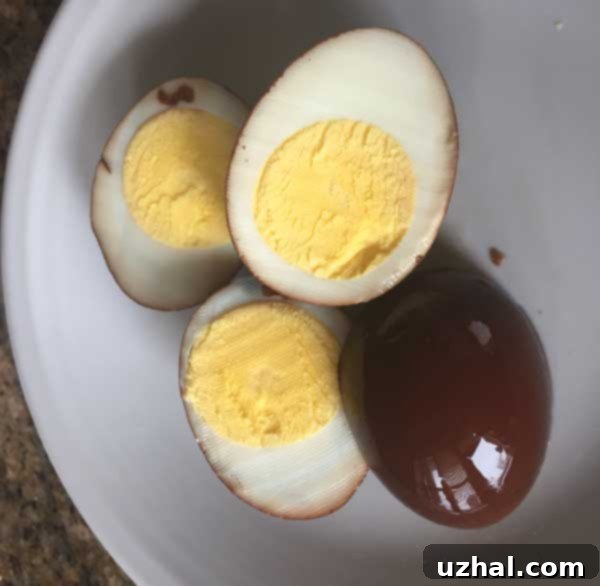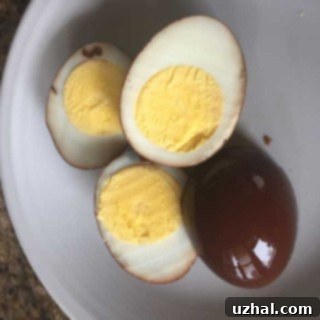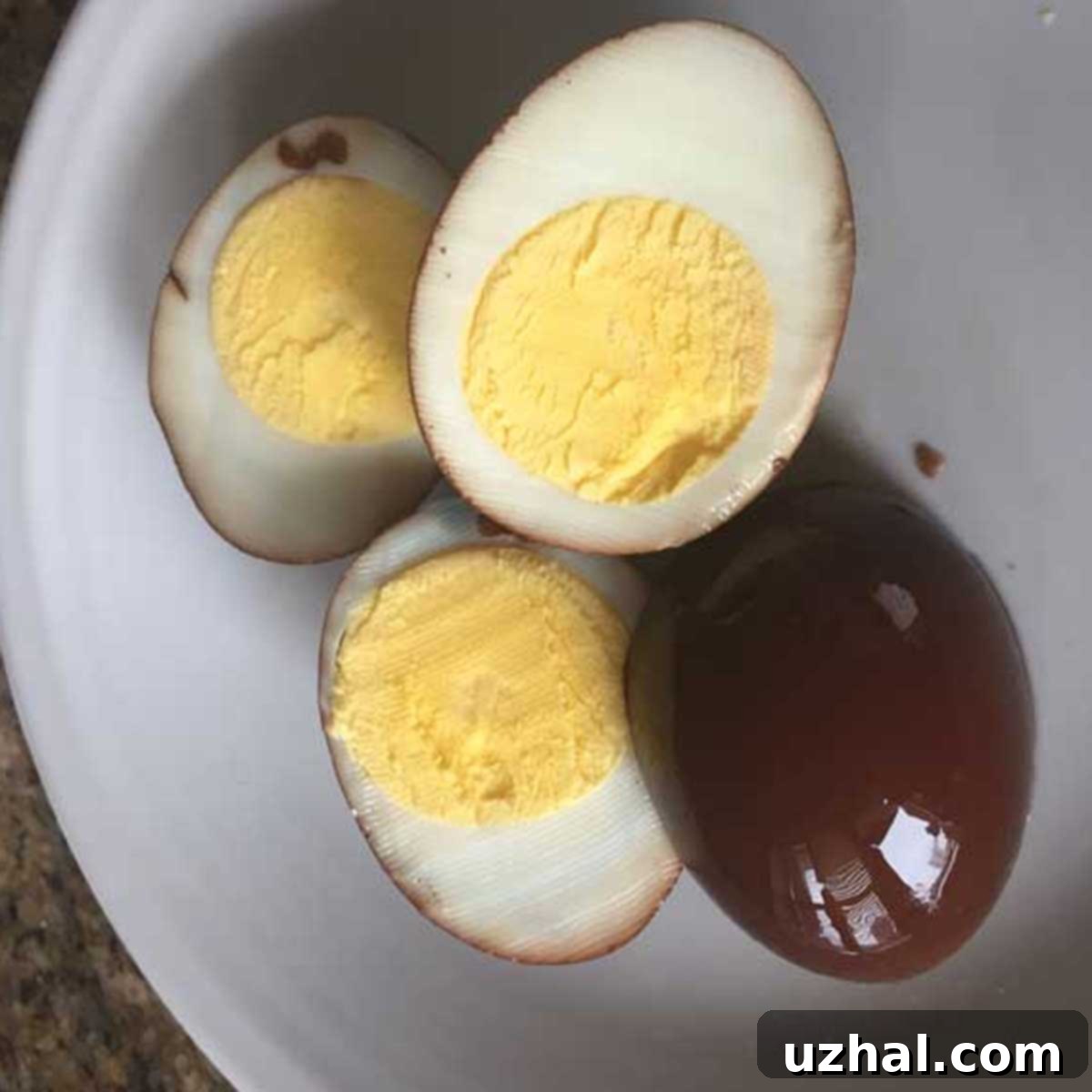Balsamic Pickled Eggs: Your Guide to Sweet, Tangy, and Perfectly Firm Pickled Eggs
Prepare to have your perception of pickled eggs transformed! For many, the idea of a pickled egg might conjure images of a humble, often overlooked snack. But for me, the discovery of balsamic pickled eggs was a revelation. My first encounter with these culinary gems was nestled within a classic club sandwich from an authentic Irish pub. The eggs, with their inviting brown tint, offered a distinct sweet, tangy, and subtly savory flavor, coupled with a remarkably firm texture unlike any other pickled egg I had tasted.

The Enchanting World of Balsamic Pickled Eggs
That initial taste sparked a culinary quest. I returned home determined to unravel the secrets behind these extraordinary pickled eggs. My research delved deep into the various methods and flavors of egg pickling. I experimented with several recipes, including Garlic Pickled Eggs and Pink Paleo Pickled Eggs. While each offered its own charm, none captured the unique deliciousness of the balsamic pickled eggs. It quickly became clear that these sweet and tangy marvels were my absolute favorite.
What sets them apart? It’s the unmistakable, yet balanced, balsamic flavor that permeates every bite, complemented by a delightful sweetness. A bonus is that this easy pickled egg recipe requires no added salt, allowing the natural flavors of the balsamic and aromatics to shine through. The result is a gourmet-level snack or appetizer that’s surprisingly simple to make at home.
So, for anyone seeking creative and delicious ways to use up those hard-boiled eggs, I wholeheartedly encourage you to give this recipe a try. You might just discover your new favorite way to enjoy eggs!
(And if you’re feeling truly adventurous, you could always explore Hard Boiled Egg Chocolate Chip Cookies – but let’s stick to the savory side for now! 😉)
Update: It seems the popularity of pickled eggs varies significantly by region! After moving from Texas to North Carolina, I’ve noticed them prominently displayed on grocery store shelves throughout Raleigh, a testament to their widespread appeal in certain areas.
Mastering Hard-Boiled Eggs: The Foundation of Perfect Pickling
The secret to great pickled eggs lies in perfectly cooked, easy-to-peel hard-boiled eggs. While the pickling brine imparts most of the flavor, the texture of the egg is crucial. Here are my preferred methods for achieving that ideal base.
How to Boil Eggs for Pickling
If you’re wondering about the best way to hard boil eggs, particularly for pickling, this method consistently delivers excellent results:
- Arrange Eggs: Gently place your desired number of eggs in a single layer at the bottom of a saucepan. Avoid overcrowding, as this can lead to uneven cooking. The pan size will depend on how many eggs you’re cooking.
- Add Water: Pour cold water over the eggs until it covers them by at least one inch, or slightly more.
- Gentle Heat to Boil: Turn the heat to medium and set a timer for 10 minutes. The goal is for the water to slowly come to a boil over this period. If your stove is very powerful, adjust the heat to ensure it takes the full 10 minutes to reach a rolling boil. Rapid boiling can cause eggs to crack.
- Rest and Cook: Once the water reaches a full boil, immediately cover the pot and turn off the heat. Let the eggs sit in the hot water for exactly 12 minutes. This residual heat gently cooks the eggs without making them rubbery.
- Ice Bath & Test: After 12 minutes, carefully remove one egg and plunge it into a bowl of ice water. Crack and peel this test egg to ensure it’s fully cooked with a firm yolk. If you’re not satisfied, you can return the remaining eggs to the hot water for a few more minutes, but usually, 12 minutes is sufficient. Once confirmed, transfer all cooked eggs to an ice bath to stop the cooking process and aid in peeling.
- Peeling Tip: Eggs that are a few days old tend to peel easier than very fresh ones. The ice bath also helps the egg white contract, separating it from the shell membrane.
Steaming Eggs for Easy Peeling
Another fantastic method, often lauded for yielding incredibly easy-to-peel eggs, is steaming. This is an excellent alternative to boiling, especially if you struggle with peeling.
- Set Up Steamer: Place your eggs in a steamer basket inside a lidded saucepan. Ensure there’s about an inch of water at the bottom of the pan, but not enough to touch the eggs.
- Steam Cook: Cover the saucepan and bring the water to a boil over medium-high heat. Once boiling, steam the eggs for about 13 minutes for perfectly hard-boiled results.
- Ice Bath: Immediately transfer the steamed eggs to an ice bath for several minutes to stop the cooking process. You’ll be amazed at how easily the shells glide off!
The Magic of the Balsamic Brine: Understanding Your Ingredients
The heart of these sweet and tangy pickled eggs is, of course, the pickling brine. Each ingredient plays a vital role in creating the distinctive flavor profile:
- Balsamic Vinegar: This is the star! High-quality balsamic vinegar will lend a rich, complex sweetness and tang. It’s naturally less acidic than white vinegar, which contributes to the unique flavor and color of the eggs.
- Water: Used to dilute the balsamic vinegar, creating a balanced pickling solution that isn’t overwhelmingly strong.
- Finely Chopped Onion: Onions add a subtle pungency and sweetness that mellows beautifully during the pickling process, infusing the eggs with a savory depth.
- Finely Chopped Garlic: Garlic is essential for a robust flavor. Its aromatic notes complement the balsamic, adding a delicious savory undertone without overpowering the main flavor.
- Sugar: A touch of sugar enhances the natural sweetness of the balsamic vinegar and balances its acidity, creating that irresistible sweet and tangy profile. This is crucial for the “sweet” aspect of these pickled eggs.
- No Added Salt: As noted in the original recipe, the absence of additional salt is a deliberate choice. Balsamic vinegar itself has a robust flavor, and many enjoy these eggs without the extra sodium, allowing the other flavors to truly shine.
Serving Suggestions for Your Tangy Treats
Once your balsamic pickled eggs are ready, the possibilities for enjoying them are endless. Their sweet, tangy, and savory notes make them incredibly versatile:
- Salads: Slice them over a green salad, a potato salad, or a pasta salad for an instant flavor and protein boost. The balsamic flavor pairs wonderfully with fresh greens and creamy dressings.
- Sandwiches & Wraps: As discovered in the Irish pub, they are magnificent sliced into club sandwiches, turkey sandwiches, or even simple egg salad sandwiches for an elevated taste.
- Charcuterie Boards: Their unique color and flavor make them a standout addition to any cheese or charcuterie board. They pair well with aged cheeses, crusty bread, and cured meats.
- Appetizers & Snacks: Serve them whole or halved as a simple appetizer. They are also a fantastic high-protein snack straight from the jar.
- Garnish: Chop them finely and use them as a garnish for deviled eggs (for a double egg delight!), soups, or even avocado toast.
Storage and Shelf Life
Proper storage is key to enjoying your homemade pickled eggs safely. Once prepared, keep them submerged in the pickling brine in a tightly sealed jar in the refrigerator. They typically last for up to 3-4 weeks. Always ensure the eggs remain fully covered by the brine to prevent spoilage and maintain their delicious flavor and texture.
Customizing Your Balsamic Pickled Eggs
While this recipe is perfect as is, you can certainly experiment with additional flavors to make it your own. Consider adding:
- Whole Spices: A few black peppercorns, a bay leaf, a pinch of red pepper flakes for a subtle kick, or even some whole cloves can add complexity to the brine.
- Fresh Herbs: Rosemary sprigs or thyme can infuse an earthy, aromatic note.
- Different Vinegars: While balsamic is the star here, a small amount of apple cider vinegar or red wine vinegar could be added for a slight variation in tang.
- Sweeteners: Adjust the amount of sugar to your preference, or try a different sweetener like maple syrup for a slightly different flavor profile.
Troubleshooting Common Pickling Issues
Making pickled eggs is generally straightforward, but here are a few common questions and solutions:
- Eggs aren’t firm enough: Ensure your hard-boiled eggs are fully cooked. For pickling, a firmer yolk is usually desired.
- Flavor isn’t strong enough: Make sure the eggs are completely submerged in the brine. Allow them to pickle for the full 5 days, or even longer (up to a week), for a more intense flavor.
- Uneven coloring: As mentioned in the recipe, rotate the jar or gently agitate the eggs every day or two. This ensures all sides of the eggs are exposed to the balsamic brine, resulting in that beautiful, even brown tint.
- Brine looks cloudy: A slightly cloudy brine can be normal due to starches or proteins from the eggs or onions. However, if it smells off, or if there’s any mold, discard the batch immediately.
Recipe

Balsamic Pickled Eggs
Cookie Madness
Pin Recipe
Ingredients
- ½ cup balsamic vinegar
- ½ cup water
- ½ cup finely chopped onion
- 3 cloves garlic finely chopped
- 1 tablespoon sugar
- 4 to 6 hard boiled eggs
Instructions
-
Prepare the Brine: In a saucepan, combine the balsamic vinegar, water, finely chopped onion, minced garlic, and sugar. Bring this mixture to a gentle boil over medium heat, stirring occasionally until the sugar dissolves.
-
Cool the Brine: Once the mixture has boiled, remove it from the heat and let it cool completely to room temperature. This step is critical; pouring hot brine over the eggs could cook them further and alter their texture.
-
Prepare the Eggs: If you haven’t already, hard boil 4 to 6 eggs using your preferred method (see “How to Boil Eggs” or “Steaming Eggs” sections above for guidance). Once cooked and cooled, peel the eggs carefully to avoid damaging them.
-
Combine and Refrigerate: Gently place the peeled hard-boiled eggs into a large, clean glass jar. Pour the completely cooled balsamic mixture over the eggs, ensuring they are fully submerged. Cover the jar tightly with a lid and refrigerate for a minimum of 5 days before serving. The longer they sit, the more intense the flavor will become.
-
Even Coloring: After a day or two in the refrigerator, give the jar a gentle rotation or carefully turn the eggs with a clean utensil. This helps ensure all sides of the eggs are evenly exposed to the brine, developing that attractive brown tint characteristic of balsamic pickled eggs.
Related Recipes & Culinary Inspiration
- Flax and Garlic Crackers
- Garlic Monkey Bread
- Rosemary Bacon Chicken over Lemon Garlic Pasta
- Small Batch Hard Boiled Egg Chocolate Chip Cookies
We hope this detailed guide encourages you to embark on your own pickling adventure. Balsamic pickled eggs are not just a snack; they are a delightful culinary experience waiting to be discovered. Enjoy the process of creating these flavorful treats, and don’t hesitate to share your experiences and variations with us!
